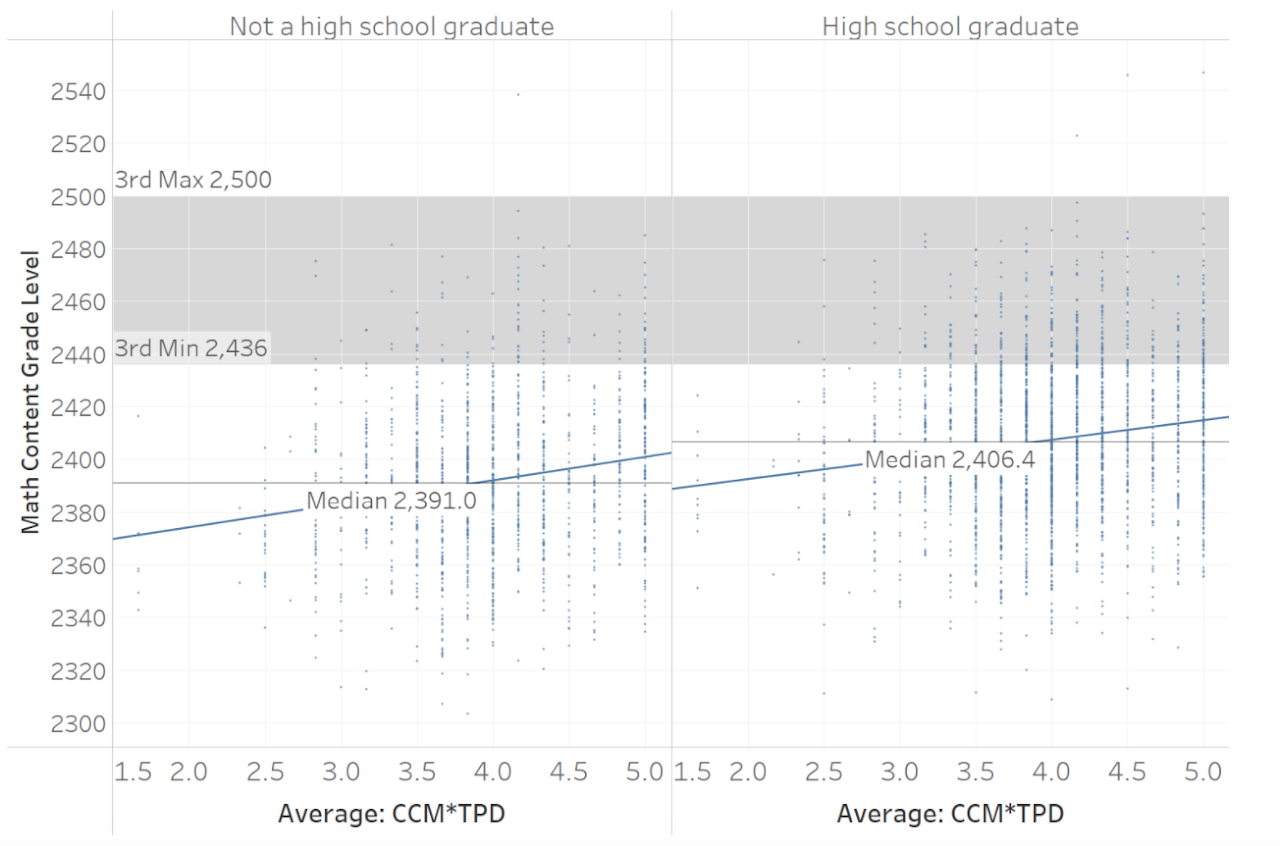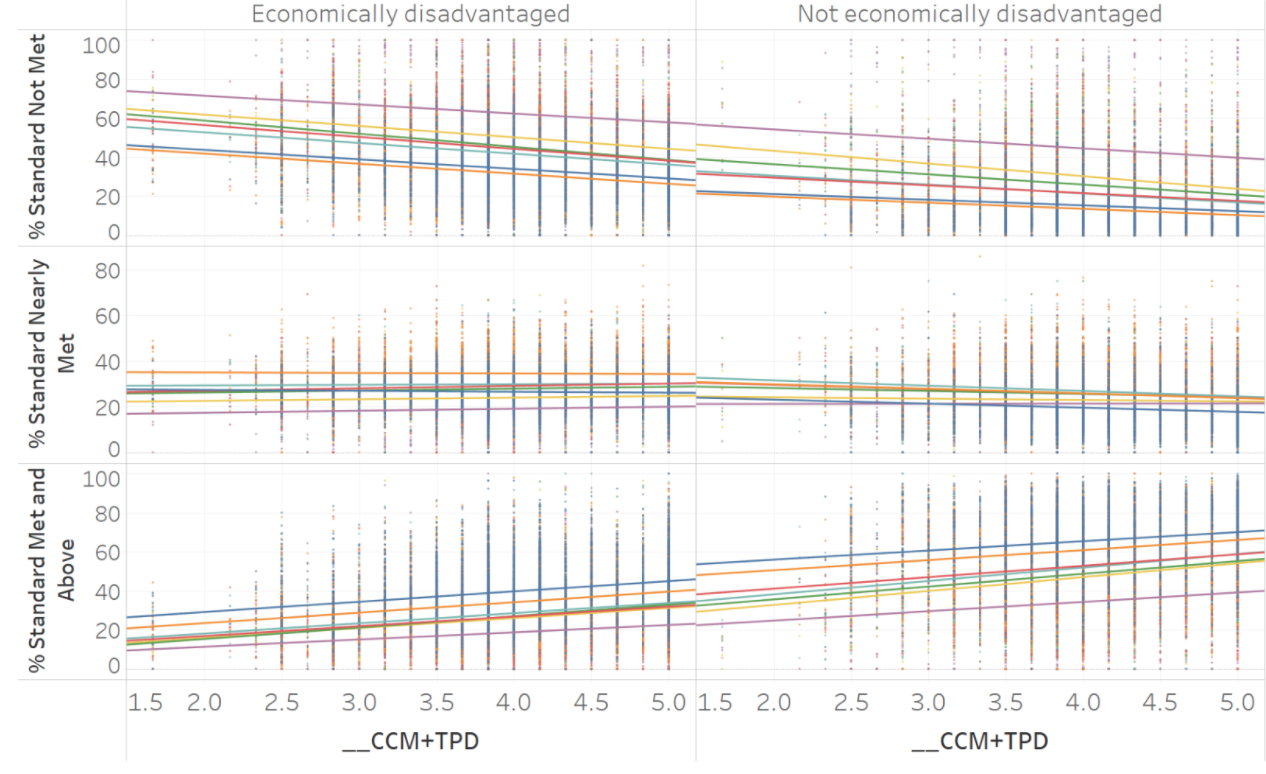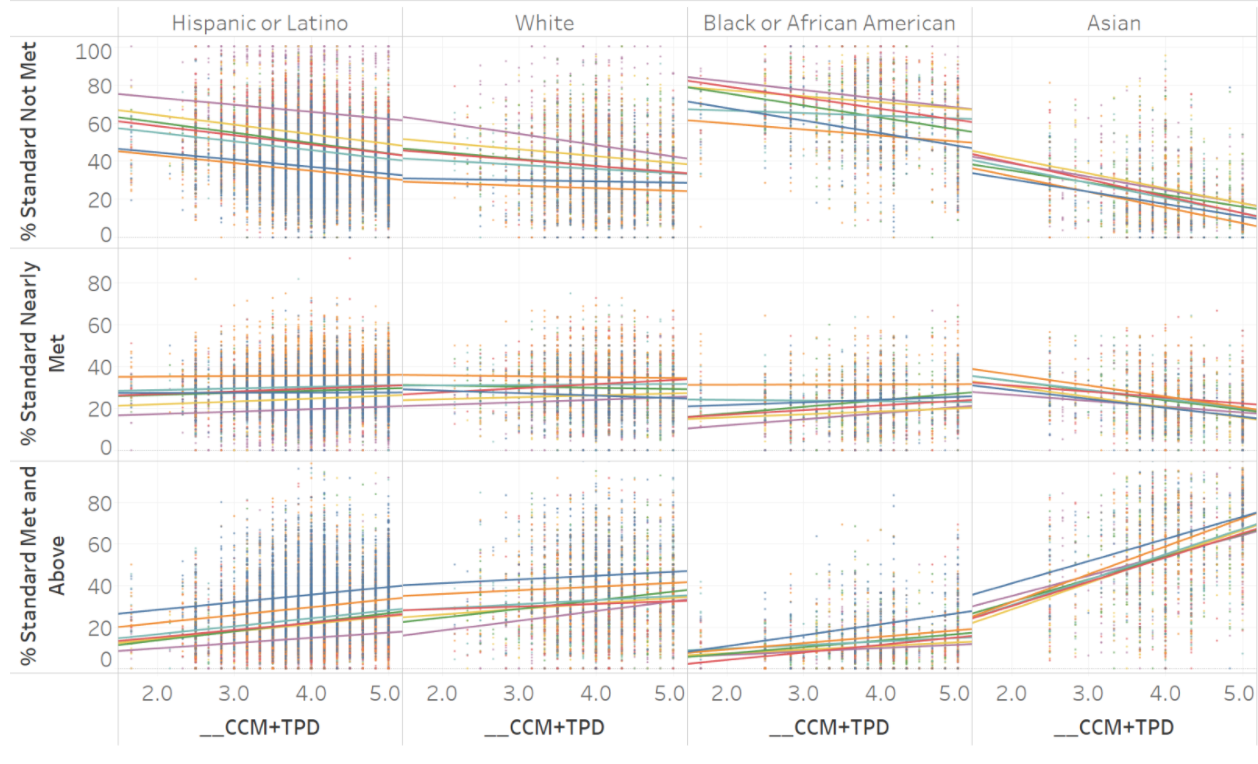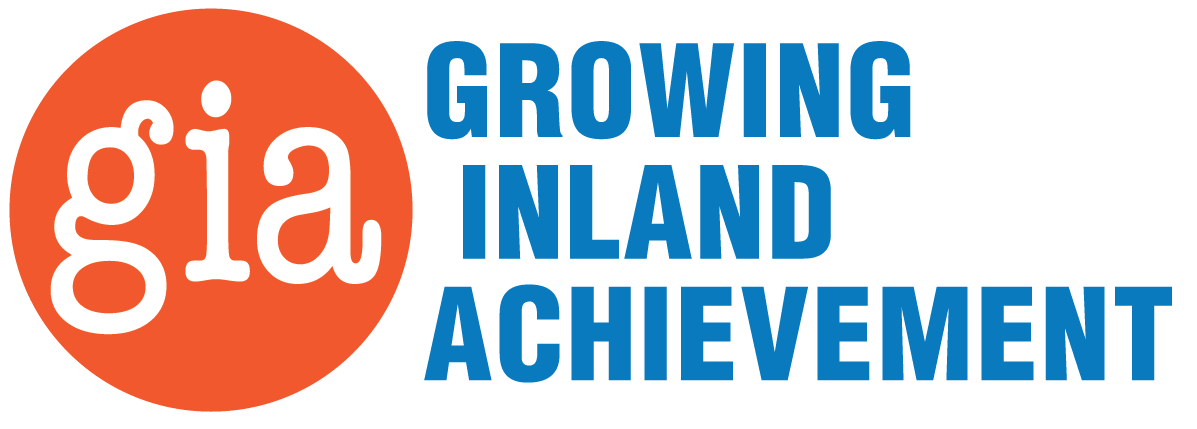The following article is a special feature on 2018-2019 California Math Achievement written by guest blogger, Marcelino Pena.
There is a great divide among California public students’ math achievement during the 2018-2019 pre-pandemic year that can literally be seen by a simple scatter plot where the Y-axis has the percent of All Students Achieving Grade Level Math Standard and the X-axis having the percent of All Students classified as Socioeconomically Disadvantaged (either the student was a migrant, foster, homeless at any time during the academic year, or they were eligible for Free or Reduced-Priced Meal (FRPM) Program (also known as the National School Lunch Program) or had direct certification for FRPM at any time during the academic year at the testing school, or the parent education level is marked as “both parents did not receive a high school diploma” at the time of testing).
But digging deeper into the publicly available datasets of the California Department of Education for 2018-2019 we find more intricate details of success and a fostering of systemic solutions that ultimately will enable the Golden State to not just meet the current devastating challenges of student economics but confront the ongoing setbacks caused by the world-wide Covid-19 pandemic.
California Department Education surveyed Local Education Agencies (School Districts) to self-assess through either their own narrative summary or using a “Self-Reflection Tool” which asks each agency to scale their level of providing professional and aligned common core standards using the following scale:
1= Exploration and Research Phase
2= Beginning Development
3= Initial Implementation
4= Full Implementation
5= Full Implementation and Sustainability
Using the above school district level of implementation and the “California Assessment of Student Performance and Progress (CAASPP) Smarter Balanced Assessments” which provides all the different student demographic math achievement levels per school we can begin to see the relationship between Common Core mathematics and overall student math achievement.
Student math achievement was shown statistically to improve significantly as the unit of implementation level increased for three major demographic controls of Parent Education, Socio-Economic, and Socio-Economic interacting with Race and most math achievements were found in Districts and Schools site commitment to level 5 implementation.
Using the Tableau dashboard available at the end you will be able to select the grades and demographics enabling yourself to see the different math achievement results based on the available dataset of 2018-2019.
Below is a sample for the Parent Education and 3rd graders across the state where the level of implementation (1 to 5) is the x-axis while the student Math Content Grade Level is the y-axis (note the grey are the expected grade level ranges for 3rd graders).

Similarly, below is a sample of SES demographics but with all Grades shown. Again, as before the Vertical Axis is the Math Content Grade Level Score and the horizontal axis is the aggregate average of all the 5 categories of Common Core Math and Teacher Professional Development, this time the grades are shown as colors from 3rd grade to 11th grade.

Lastly, this is an example of the interaction of Low SES and Race who I have shown in the beginning to be the majority of California and therefore, the key students of our study. These are the students that California must focus its attention on, and we can again see a strong trend in the right direction as the level of implementation increases for each group of students. Here we want the percentage volumes to go from Not Met to Met and Above so this model must be replicated every year to determine how the percentages have changed from Not Met to Met and Above.

Socio-Economic Status (SES) and Common Core Mathematics show how SES exacerbates foundational mathematical acquisition, Schmidt 2021 “The Role of Opportunity to Learn in Ethnic Inequality in Mathematics.”, and the overall framework of Common Core Mathematics can be described as the five interwoven strands of Conceptual Understanding (math concepts), Procedural Fluency (math applications), Strategic Competence(use math appropriately), Adapting Reasoning(create mathematically), and Productive Disposition(value math as an essential tool), Kilpatrick et al., 2001 “Adding It Up, Helping Children Learn Mathematics”. Thus, Common Core Mathematics pulls together the hallmark concepts of “Coherence” and “Opportunity to Learn” that empower every student regardless of SES the keys to the infinite doors they will encounter in their futures.
Finally combining professional teacher development with common core mathematics is like putting Alteryx and Tableau together or peanut butter and jelly namely having the best of both worlds that is the science and art. In Darling-Hammond 2020 “Implications for the educational practice of the science of learning and development” science of learning and development (SOLD) we find the following key importance:
“…children have individual needs and trajectories that require differentiated instruction and supports to enable optimal growth in competence, confidence, and motivation.
From an ecological systems framework, the school serves as an immediate context shaping children’s learning and development through instruction, relationships with teachers and peers, and the school culture.”
What we find ultimately is that critical independent thinking is fostered in communal environments of support that allowed students to be challenged to answer their own questions. Or as the late great scholar Robert Moses stated in his 2002 “Radical Equations, Civil Rights from Mississippi to the Algebra Project”:
“Teachers, of course, are another part of this equation. It should be clear by now that underlying our curriculum and pedagogy is the expectation that teachers will make fundamental changes in the way they teach. They cannot simply be lecturers attempting to pour knowledge into their heads of students who sit passively like inanimate vessels.”
The research document below provides all the details on California math achievement for 2018-2019 and hope to receive many questions from all California stakeholders, including students and parents.
Media inquiries and questions should be directed to Marcelino Peña, Organization Optimization Engineer / Tableau Developer / Math Educator, [email protected]. For more information visit www.mathpowerimagination.com.

